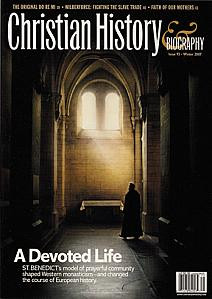Benedict Biscop Scrounged Precious Books and Art for England's Church

Baducing contributed greatly to the development of English culture and Christianity.
ENGLISH SCHOLARSHIP, arts, architecture, and monasticism all owe an enormous debt to Biscop Baducing. Born into the Anglo-Saxon nobility around 628, when he was twenty-five he renounced wealth and high office in the court of King Oswald of Northumbria to pursue a religious life. He even changed his name to Benedict Biscop. He soon made a trip to Rome with his friend Wilfred (later an archbishop) and upon returning to England devoted himself to prayer and Bible study. After a second trip to Rome, he lived in the French monastery at Lérins to learn its ways. His third trip to Rome ended when the pope sent him back, this time as an assistant to Theodorus whom he had appointed Archbishop of Canterbury.
Theodorus made Biscop the temporary head of the monastery of Saints Peter and Paul near Canterbury. Biscop soon relinquished this job to St. Adrian and made a fourth trip to Rome on which he also visited notable monasteries of Europe. He brought home books and works of religious art. Obtaining a land grant from King Egfrid of Northumbria, he founded a monastery at the mouth of the Ware river (Wearmouth), where he housed the treasures he had brought from Rome.
Biscop imported skilled masons from France to erect a monastery church, since the art of stone construction and stained glass was virtually unknown in England. He drew up Wearmouth’s rules after careful examination of seventeen of Europe’s most successful monasteries. Wearmouth proved so successful that eight years later King Egfrid granted Biscop a second tract of land on which he built another monastery six miles away at Jarrow.
Hundreds of young men received their education at the monastery schools of Wearmouth and Jarrow. The most famous of these was Bede. He was placed in Biscop’s care as a young boy of seven. It was thanks to the large library Biscop collected that Bede was later able to write his famous history of the English church. Biscop also engaged Abbot John, archcantor (music leader) of St. Peter’s in Rome, to teach Roman chant at Wearmouth and Jarrow.
The last three years of his life, Biscop suffered a paralysis to the lower half of his body. But he remained cheerful. When the monks recognized that they would soon have to select a new abbot, he urged them to choose their leader not for noble blood but for spiritual maturity. He died on this day 12 January 690, having labored for most of his adult life to provide religious training to the Anglo-Saxons of his native land.
—Dan Graves
----- ----- -----
For more on Wearmouth and its most famous scholar, the Venerable Bede, read "When God Came to England" in Christian History #72, How We Got Our History
Another short article on Bede, "A Monk Who Made History," can be found in Christian History #93, A Devoted Life: St. Benedict & Western Monasticism







